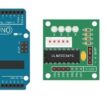Soil moisture sensor

What is a soil moisture sensor ?
Soil moisture sensors are devices used to measure the amount of moisture present in the soil. These sensors are an essential tool in agriculture and irrigation, as they provide critical information on the water needs of plants. Here are some of the key features and benefits of soil moisture sensors:
Accuracy: Soil moisture sensors provide accurate and real-time data on soil moisture levels, allowing for precise irrigation scheduling and optimal water management.
Non-destructive: Soil moisture sensors can be inserted into the soil without damaging the plants or the soil structure, allowing for non-destructive measurements of soil moisture.
Versatility: Soil moisture sensors come in various types and sizes, making them suitable for a wide range of applications. Some sensors can be used for field-scale monitoring, while others are designed for use in potted plants or greenhouse environments.
Cost-effective: Soil moisture sensors are cost-effective and can be used repeatedly, making them an affordable and sustainable option for monitoring soil moisture levels.
Improved plant health: By providing accurate information on soil moisture levels, soil moisture sensors can help prevent overwatering or underwatering of plants, promoting healthy growth and reducing the risk of disease.
Types of soil moisture sensor
There are several types of soil moisture sensors, each with its own advantages and disadvantages. Here are some of the most common types of soil moisture sensors:
Tensiometers: Tensiometers are devices that measure soil moisture tension, which is the force required to extract water from the soil. Tensiometers are simple to use and provide accurate measurements of soil moisture in the root zone of plants. However, they require frequent maintenance and may not be suitable for use in soils with high salt content.
Time-Domain Reflectometry (TDR) Sensors: TDR sensors measure the dielectric constant of the soil, which is related to the soil moisture content. TDR sensors provide accurate and real-time data on soil moisture levels and can be used in a wide range of soil types. However, they are relatively expensive and may require calibration for different soil types.
Capacitance Sensors: Capacitance sensors measure the soil's ability to store an electrical charge, which is related to the soil moisture content. Capacitance sensors are easy to use and provide reliable measurements of soil moisture in a wide range of soils. However, they can be affected by soil salinity and may require calibration for different soil types.
Resistance Blocks: Resistance blocks measure the electrical resistance of the soil, which is related to the soil moisture content. Resistance blocks are inexpensive and easy to use, making them a popular choice for home gardeners and farmers. However, they may not provide accurate measurements in clay soils or soils with high salinity.
Neutron Probe: Neutron probes measure the amount of water in the soil by detecting the number of neutrons emitted by hydrogen atoms in the soil. Neutron probes provide highly accurate measurements of soil moisture levels but are relatively expensive and require special training to use.
Soil moisture sensor pins
The pins of a soil moisture sensor can vary depending on the model and manufacturer. However, most soil moisture sensors typically have two pins:
The VCC (or VDD) pin: this is the power supply pin which is used to provide a supply voltage to the sensor. The supply voltage may vary depending on the model and manufacturer, but is usually 3.3 V or 5 V.
The signal pin: this is the pin that sends the measurement data from the sensor to the electronic card or to the microcontroller. The output voltage of this pin varies depending on the level of humidity detected by the sensor.
The ground pin (GND)
Microcontrollers and soil moisture sensor
irrigation systems that can automatically adjust watering schedules based on the actual moisture content of the soil. A microcontroller is a small computer that can be programmed to perform specific tasks, such as reading data from a soil moisture sensor and controlling a water pump or valve.
Here's how a typical microcontroller-based smart irrigation system might work:
A soil moisture sensor is installed in the soil, and the sensor's pins are connected to the input pins of the microcontroller.
The microcontroller is programmed to read the soil moisture sensor's output at regular intervals, such as every hour.
The microcontroller compares the actual soil moisture reading to a pre-defined moisture threshold value, which is based on the specific plant's water requirements and the soil type.
If the soil moisture reading is below the threshold value, the microcontroller sends a signal to a water pump or valve to turn on and irrigate the soil.
The microcontroller continues to monitor the soil moisture levels and adjusts the watering schedule accordingly, turning off the water pump or valve when the soil moisture level reaches the desired level.
By using a microcontroller-based smart irrigation system, farmers and gardeners can save water and ensure that their plants receive the correct amount of water at the right time. The system can also be programmed to adjust watering schedules based on weather conditions, further optimizing water usage.
The Arduino and the Soil Moisture Sensor
The Arduino is a popular microcontroller platform that can be used in conjunction with a variety of sensors, including soil moisture sensors, to create smart irrigation systems or other environmental monitoring applications.
Here's how the Arduino can be used with a soil moisture sensor:
1- Connect the soil moisture sensor's power and ground pins to the 5V and GND pins on the Arduino, respectively.
2- Connect the sensor's output pin to an analog input pin on the Arduino, such as A0.
3- Write a program for the Arduino that reads the analog value from the soil moisture sensor and converts it to a soil moisture level in percentage or other unit.
4- Use the program to set a threshold value for the soil moisture level, and program the Arduino to turn on a water pump or valve when the soil moisture level falls below the threshold.
5- Add additional features to the program, such as timing functions or weather-based adjustments, to create a more sophisticated smart irrigation system.
Soil moisture sensor Programming
Programming a soil moisture sensor involves reading the sensor's output signal and converting it into a meaningful soil moisture value. Here's a general overview of the steps involved in programming a soil moisture sensor:
1- Connect the soil moisture sensor to your microcontroller board. Make sure to connect the power and ground pins correctly, and connect the signal pin to an appropriate input pin on the microcontroller.
2- Determine the voltage range and output format of your soil moisture sensor. Some sensors output an analog voltage signal, while others output a digital signal.
3- Write a program to read the sensor's output signal. For an analog sensor, you can use the "analogRead()" function in Arduino or similar platforms to read the voltage level on the input pin. For a digital sensor, you may need to use a library or write custom code to interpret the signal.
4- Convert the sensor's output signal into a soil moisture value. This involves mapping the voltage level to a soil moisture percentage or other unit. The exact conversion formula will depend on the specific sensor and its calibration.
5- Use the soil moisture value to trigger actions, such as turning on a water pump or sending a notification.
6- Consider adding additional features to your program, such as logging data over time, adjusting watering schedules based on weather data, or integrating with other sensors or devices.
Role of soil moisture sensor in robotics
Soil moisture sensors can play an important role in robotics applications, particularly in agricultural robots and other autonomous systems that operate in natural environments. Here are some ways that soil moisture sensors can be used in robotics:
Irrigation control: Soil moisture sensors can be used to determine when and how much to water plants, allowing robots to perform precision irrigation based on the specific needs of each plant. By using soil moisture sensors, robots can avoid over-watering or under-watering plants, which can improve crop yield and reduce water waste.
Plant health monitoring: Soil moisture sensors can provide information about the health and stress levels of plants. By continuously monitoring soil moisture levels, robots can detect signs of drought stress or other issues that could affect plant growth and yield.
Mapping and analysis: By collecting data from multiple soil moisture sensors over time, robots can create detailed maps of soil moisture levels across a field or other area. This information can be used to optimize irrigation, analyze soil fertility, and improve crop management practices.
Environmental monitoring: Soil moisture sensors can also be used to monitor other environmental factors, such as temperature and humidity, which can affect plant growth and health. Robots equipped with soil moisture sensors and other environmental sensors can collect data in real-time, enabling precise monitoring and control of the growing environment.
Role of Soil Moisture Sensor in Smart Irrigation Systems
Soil moisture sensors play a crucial role in smart irrigation systems by providing real-time information about the moisture content in the soil. Here are some ways that soil moisture sensors can help optimize irrigation:
Precise watering: By measuring soil moisture levels, smart irrigation systems can deliver the exact amount of water that plants need, at the right time. This can help reduce water waste and prevent over-watering, which can lead to soil erosion, nutrient leaching, and other problems.
Water conservation: Soil moisture sensors can help reduce water consumption by preventing unnecessary watering. For example, if the soil moisture levels are already high, the smart irrigation system can delay watering until the moisture levels drop below a certain threshold.
Plant health: Soil moisture sensors can also help improve plant health by ensuring that plants receive the right amount of water. Under-watered plants can become stressed and more susceptible to disease and pests, while over-watered plants can develop root rot and other issues.
Remote monitoring: Smart irrigation systems equipped with soil moisture sensors can be monitored remotely, allowing farmers and gardeners to track soil moisture levels and adjust watering schedules from anywhere. This can help save time and reduce labor costs, while ensuring that plants receive optimal care.
























